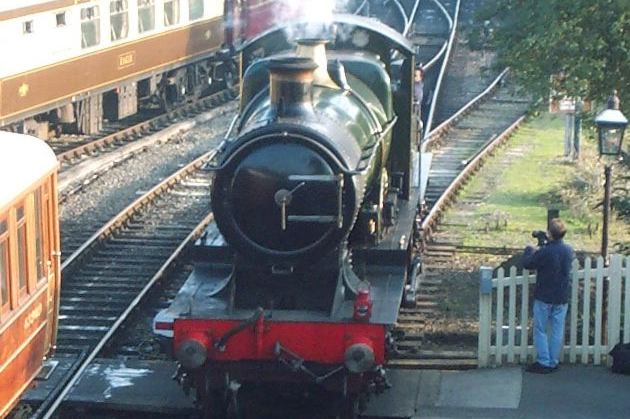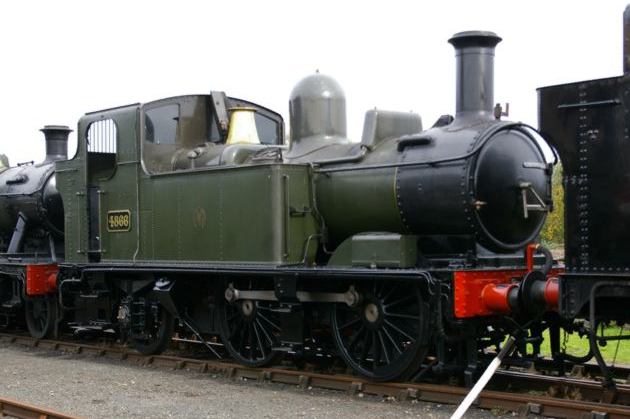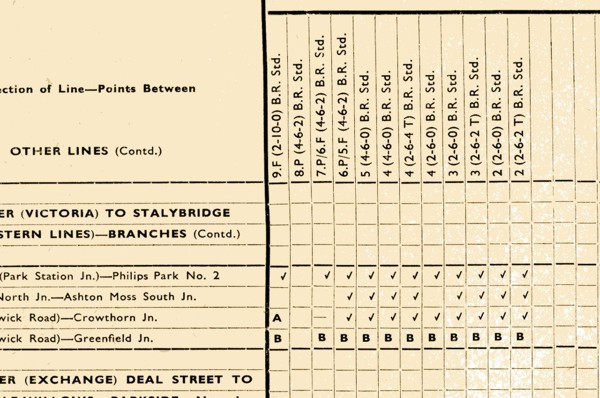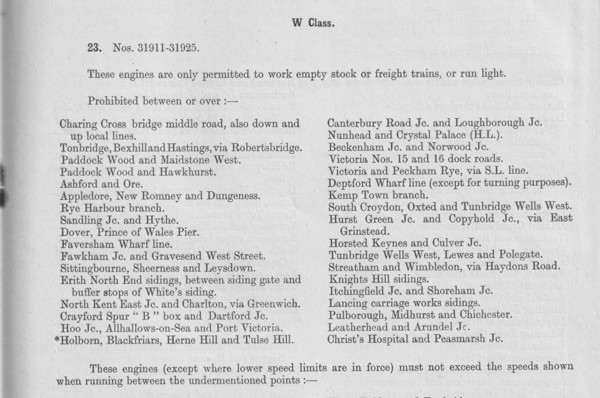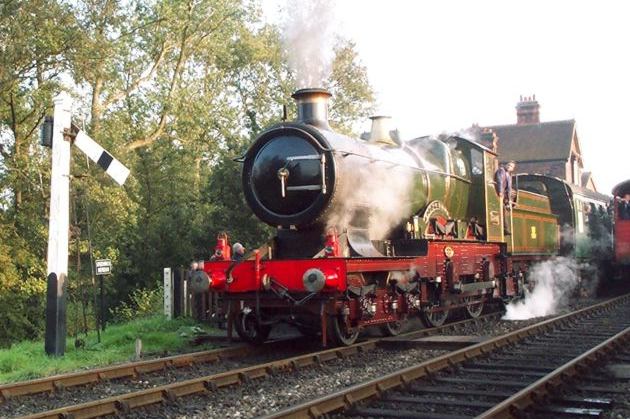Historical Route Availability Classification
This page is intended to provide a basic introduction to the route availability classification in use on the British railway systems in the steam era.
Route availability classification was by no means universal in the steam era. In general which locomotives could be used on which routes was detailed in documents such as (on the GWR) the service timetables, which detailed what was allowed to run where in considerable detail, often down to individual classes and individual sidings. The LMS and the SR never seem to have felt the need to have a more general system. Even by the early 1960s a LMR Locomotive Route Availability document listed individual classes against the various sections of line.
The GWR, on the other hand, introduced a general classification from about 1905, which was fully implemented in 1919, and contained five categories based solely on axle loading. The classification was identified by a coloured circle on the cabside, which corresponded to the use of the same color on the official GWR route maps.
The LNER introduced a similar classification in their southern area in 1940, which was extended to the whole of the LNER in 1947. The LNER system was a little more sophisticated than the GWR one, and made allowances for the weight per foot length of a locomotive. An example of this is the classification of the LNER 04/GWR ROD locomotives, which were classified as RA6 by BR, and Blue by the GWR. By axle loading alone GWR Blue classification was between LNER RA4 and RA5.
The LNER system was adopted by BR as a whole, and in highly modified form is still in use. However the WR continued to use its own route colour system through the steam era, and its not yet clear to me when the Southern and London Midland regions started to adopt it in practice. Certainly a 1961 LMR route availability document lists individual classes and makes no mention of RA numbers.
It should be noted that even where the formal systems existed they were not the end of the matter. There were also specific local restrictions included in service or working timetables, and of course loading gauge was also a consideration.
| Table of Axle loadings | |||||
|---|---|---|---|---|---|
| Authority | RA Code | Imp. Tons | Imp. Cwt | Tonnes | |
| NR 2021 | RA1 | 13 | 15 | 13.95 | *** |
| LNER 1947 | RA1 | 13 | 15 | 13.95 | * |
| GWR | uncoloured | 14 | 0 | 14.20 | |
| NR 2021 | RA2 | 15 | 0 | 15.20 | *** |
| LNER 1947 | RA2 | 15 | 0 | 15.25 | * |
| GWR | Yellow | 16 | 0 | 16.25 | |
| LNER 1947 | RA3 | 16 | 5 | 16.50 | * |
| NR 2021 | RA3 | 16 | 5 | 16.50 | *** |
| LNER 1947 | RA4 | 17 | 5 | 17.55 | * |
| NR 2021 | RA4 | 17 | 9 | 17.75 | *** |
| GWR | Blue | 17 | 12 | 17.90 | |
| LNER 1947 | RA5 | 18 | 2.5 | 18.40 | * |
| LNER 1947 | RA6 | 18 | 15 | 19.05 | * |
| NR 2021 | RA5 | 18 | 15 | 19.05 | *** |
| GWR | Red | 19 | 12 | 19.90 | |
| NR 2021 | RA6 | 19 | 20 | 20.30 | *** |
| LNER 1947 | RA7 | 20 | 0 | 20.30 | * |
| NR 2021 | RA7 | 21 | 4 | 21.55 | *** |
| LNER 1947 | RA8 | 21 | 5 | 21.60 | * |
| GWR | double red | 22 | 10 | 22.85 | ** |
| LNER 1947 | RA9 | 22 | 10 | 22.85 | * |
| NR 2021 | RA8 | 22 | 10 | 22.85 | *** |
| NR 2021 | RA9 | 23 | 14 | 24.10 | *** |
| NR 2021 | RA10 | 24 | 20 | 25.40 | *** |
* LNER RA was not based solely on axle loading, but included weight per unit length.
** Usually given as > 17.12 and not a King. 19:12 was the usual maximum on red route locomotives, but some Hawksworth locos were 19:14 and the sole GWR pacific, The Great Bear, which was not permitted on all red routes, was 20T.
*** Based on the example in Network Rail documentation of a two axle vehicle. The weight per unit length and weight distribution are among other factors considered.
The GWR and WR Route Map
The route map was a work in progress and had to be updated as weight restrictions were eased on various lines. Copies were issued as appropriate: for example to locomotive sheds. A copy of one version of the map is available here. There were in fact seven route classifications to go with the five route colours:
| Route Marking | Route Miles (1938) | Percentage of GWR System | Restrictions |
|---|---|---|---|
| Hatched Red | 522 | 14% | All locomotives |
| Red | 1,280 | 34% | All locomotives except King Class. |
| Dotted Red | 295 | 8% | No King Class. Red engines must not exceed 20 m.p.h. |
| Blue | 320 | 9% | No red engines |
| Dotted Blue | 150 | 4% | No red engines and blue engines must not exceed 25 m.p.h. |
| Yellow | 695 | 18% | No red or blue engines. |
| Uncoloured | 495 | 13% | Only uncoloured engines. |
The table is from the GWR magazine of 1938. It was GWR policy to upgrade the carrying capacity of bridges as they fell due for replacement, so the amount of higher capacity mileage tended to increase. In particular there was a considerable mileage upgraded during WW2 to facilitate military traffic, notably parts of the Cambrian main line and the Didcot, Newbury and Southampton line.
The LNER scheme
I understand this is documented in more detail in RCTS' "Locomotives of the LNER Part One". I believe there was a route category to match each locomotive category.
The LMS/London Midland Region
The LMS didn't have a formal classification scheme in the same way as the GWR and LNER, but it was still an active issue. By 1961 the LMR Line Traffic Manager issued booklets for various sections of the line containing tables showing various sections of lines and branchlines on the left and a list of classes along the top, with a grid showing with a grid containing a tick where a class was permitted. The booklet doesn't make a distinction between restrictions from weight and restrictions from gauging issues. An extract from the 1961 document is shown below.
The Southern Railway/Region
Like the LMS, the SR never had a formal scheme with locomotives and routes classified, but the restrictions were nevertheless important. Holcroft, in "Locomotive Adventure" tells us about specific problems with the SECR lines which tended to be lighter built, and that the SECR issued a route map coloured for different weight restrictions. By 1949 the Southern region was issuing a locomotive restrictions booklet for various sections, which took the approach of listing each class, and then, in text, listing where the class was not permitted to run. Again no distinction was made between weight and gauge restrictions. An extract is shown below.
The Current Network Rail scheme
This is an evolution of the LNER scheme, and as is evident several of the categories are unchanged, but the method of calculation has become more sophisticated. Roughly speaking the calculations seek to establish the worst case loading from a 100m train of the vehicle in question crossing a 50m span bridge. There is much more - the current RSSB document describing the scheme is GERT8006, which can be found from the RSSB web site, but you do need to register to use the RSSB sites. The RA figures are calculated using software available to the rail industry but I have yet to find the formula in use.
Each structure is now individually classified with a RA number, which, combined with the use of an IT database, gives much more flexibility in finding suitable routes for heavy traffic. Special arrangements are made for the few spans over 50m on the network.
Acknowledgements
Thanks to: RSSB, The editors of RCTS' "Locomotives of the GWR Part One", 'bluetrain' and 'Dunfanaghy Road' on the National Preservation forum, 'Jim.Snowden', Jim Norman, Neil Knowlden/Southern Railways Group on the RMweb forum and others who I have failed to record.
You may also be interested in this related study ofBritish Historic Loading Gauges
